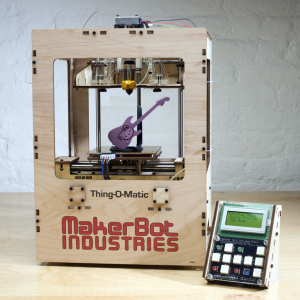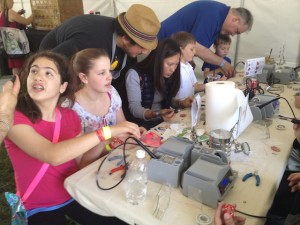UPDATE: Check out the comments, where reader J links to videos of a 3D-printed guitar and violin.It’s cool and INTENSE.
Last weekend I got to enjoy one of my favorite things in the universe: the Maker Faire, held each year in San Mateo, California, outside San Francisco.
The event, which draws 100,000 people each year (not counting the thousands who attend satellite fairs in NYC, Detroit, and other cities), was launched by Make magazine, the closest thing to a house publication for the international DIY movement. Adherents of maker culture — or just plain “makers” — are a loose aggregation of artists, geeks, hackers, Steampunks, subversive ETSY craftspeople, and others who embrace various facets of DIY culture. “If you can’t open it, you don’t own it” is one of many unofficial mottos. Another is “Void your warranty, violate a user agreement, fry a circuit, blow a fuse, poke an eye out…”
And who isn’t in favor of poking out a few eyes? 😉
The Faire, now in its eighth year, is a joyous affair, assuming you derive joy from things like flashing Van der Graaf generators, 50-foot-tall kinetic sculptures that spew fire, the Faire’s iconic cupcake cars, and the sight of hundreds of cute kids learning to solder DIY projects at rows of workstations.
Each year there’s more new stuff than you can possibly consume, but even even amidst the ear-pounding experimental music and eye-pounding LED art, one development seemed to dominate: 3D printers are getting faster, smarter, and cheaper (as in, several DIY kits sell for less than $500). And it’s difficult to imagine them not changing how we will create and mod our musical instruments in the very near future.
I’m pretty much a 3D printing ignoramus — if you read this short Wikipedia article, you’ll know more than I do. The basic idea is, designers create 3D images using CAD (computer-assisted design) software. These are interpreted as many thin, horizontal slices, which the computer “prints”using liquefied plastic and other materials.
The current limitations are formidable: The inexpensive hobbyist models can still only print small objects (one-foot square, max, and usually less). They’re slow — printing a model can take many hours. They’re monochrome (though one vendor told me they’re working on a multicolor machine that mixes colors in the manner of an inkjet printer). And most entry-level models can create only light-duty plastic objects, though at least one company, Zen Toolworks, sells a $1,000 machine that can also etch metal, and can be fitted with an attachment to fashion wooden objects. (Some 3D printers use liquid compounds infused with metal to create objects that look and feel metallic, though for now, this exceeds the power of the lower-cost hobbyist machines).
It doesn’t take a vast amount of imagination to see all this leading to some very exciting DIY developments!
You don’t even need your own printer to play — service companies like Ponoko can fabricate objects for you from your digital designs. Even better, maker clubs in many cities pool resources via communal workspaces. (Here’s a fantastic list or maker spaces compiled by Make magazine.)
I don’t know about you, but I want to learn more about this stuff for music/DIY applications! I’ve signed up for some classes at San Francisco’s TechShop. It’s a liberating experience for a guy who never got to use the cool machines in middle school shop class, because I spent the whole semester struggling with the the first project, a 6″ x 4″x 1″ block of wood. While other kids were making baseball bats and lamp stands on the lathe, I was laboring away at “Block, rev. 97.” I’ll let you know how it goes, assuming I emerge from the workshop with sufficient typing fingers.
Anyone out there have experience with this stuff? Any thoughts about how it might apply to music, instrument making/hacking, and other risky behaviors? Please share your smarts!










Cool article Joe! It’s going beyond parts-Check out this 3D Printed Violin…
https://www.youtube.com/watch?v=bJA6J5girlo
…and apparently, guitars too!
https://www.ubergizmo.com/2012/04/3d-printed-guitar-playable/
Warwick and Jerzy Drozd Basses already use extensive CNC routing (think drill bit cutting if that makes no sense)…this is going to have a significant impact on the future…! :thumbup:
Wow — thanks for the INCREDIBLE links. That violin and guitar are just amazing. 🙂
I’ve been fascinated with 3d printers for quite some time! Eyeing off a makerbot replicator. My goal is to print an acoustic arch top body and stick a neck and hardware on there and see how it sounds. But 3d printers are great for replacing broken parts on a guitar, especially if they’re hard to get. I wish I had one around when trying to mouto a tele bridge pickup in a humbucker routing, I could have just printed a custom pickup ring instead of screwing it to the body.
I have been using some guitar picks that were produced by Shapeways (in he Netherlands and now in New York). They are built on 3D printers out of numerous materials. One is a steel type substance the others are various types of plastic. They are adding new materials all the time.
https://www.shapeways.com/model/85820/upgraded-dual-guitar-pick.html
These are a real unique and useful design with 2 different thicknesses for lead and rhythm uses. These were designed by a Shapeways user. You can buy them in various materials of your choice. There is also A project for a guitar style instrument mostly made of 3d printed parts at: https://www.designboom.com/weblog/cat/8/view/4957/zoybar-guitar.html
Its worth a look it is very futuristic.
There are many folks that feel that 3d printers will one day become a household device and many products will be custom manufactured in the home. There are also medical applications a heart valve and other devices along with prosthetic devices are produced on 3d printers. They are used for archetectural models as well as iPhone cases, toys and other point of purchase manufactured goods. There is even research being done in printing medicines. This is the wave of the future. IMHO
That looks to have potential , just a matter of what direction advancements take it. Good luck with the shop class Joe and watch your fingers !
Hey Matthew,
Following your link on designboom I went to see their website very cool guitars indeed!
https://www.zoybar.net/main